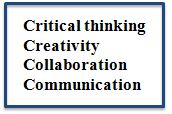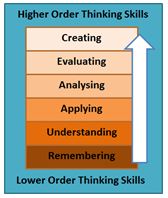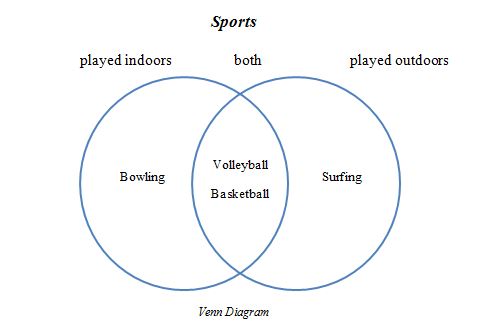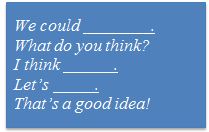 Kathleen Kampa and Charles Vilina are American ELT authors and teacher-trainers who have taught young learners in Japan for 25 years. They are co-authors of Magic Time, Everybody Up, and Oxford Discover, courses for young learners published by Oxford University Press. Kathleen and Charles are active teachers who promote an inquiry-based approach to learning, where students develop English language fluency as they discover the world around them.
Kathleen Kampa and Charles Vilina are American ELT authors and teacher-trainers who have taught young learners in Japan for 25 years. They are co-authors of Magic Time, Everybody Up, and Oxford Discover, courses for young learners published by Oxford University Press. Kathleen and Charles are active teachers who promote an inquiry-based approach to learning, where students develop English language fluency as they discover the world around them.
The Partnership for 21st Century Learning in Washington D.C. strongly endorses the development of 21st century skills in modern education.[1] This coalition of educators and business leaders has created a framework of skills considered to be essential for a student’s future success in the 21st century.
Along with strong content knowledge and interdisciplinary themes, the Partnership stresses the need for the following “learning and innovation skills” among students to prepare them for the future:

Though originally intended for students in the US, the framework has been successfully adopted by hundreds of educational agencies and organizations globally.
Not surprisingly, 21st century skills have become an important focus in English language learning (ELL) classrooms as well. In fact, it could be argued that effective English language educators have been incorporating these skills in their curriculum for many years, for the very reason that they contribute to language fluency among their students.
Let’s look at each “learning and innovation skill” as it applies to ELL classrooms, and how it offers opportunities for increased fluency.

Critical Thinking
Critical Thinking is a student’s ability to move from the lower-order thinking skills of remembering and understanding to the higher-order skills of applying, analyzing, and evaluating (see Bloom’s Revised Taxonomy below).
Through critical thinking, students process information in a variety of ways – for example, through prioritizing, comparing/contrasting, and classifying/categorizing. Learning is real and relevant, and offers many opportunities for students to discuss the content meaningfully.

Bloom’s Revised Taxonomy[2]
Example:
A Venn diagram is one way to challenge students to think critically about information. A Venn diagram involves comparing and contrasting, and can be used effectively when introducing topics. For example, students could place a vocabulary list of sports into a Venn diagram labeled “played indoors,” “played outdoors,” or “played both indoors and outdoors.”

The teacher could provide the following language prompt to guide students:


Creativity
Creativity is closely associated with critical thinking, and is placed at the top of Bloom’s Revised Taxonomy as one of the highest-order thinking skills. Creativity allows students to make new connections, to take what they have learned to solve problems, and to express themselves in unique ways.
Example:
Problem-solving offers opportunities for students to be creative. For example, if the lesson’s topic is about plants, students can be asked for ideas on how to use plants in or around school. Students work in small groups to brainstorm ideas and draw illustrations, with the teacher moving around the room offering language support. Then, in a whole-class activity, ideas are listed and prioritized on the board.
Possible language prompt:

Collaboration
Collaboration is the ability to work with others, to share ideas, to discuss options, and to compromise. Working in pairs or small groups is one of the most effective ways for students to build their social language skills while reinforcing newly learned vocabulary and grammar.
Example:
Collaborative projects often involve groups of four students. Students can work together to create a time capsule, present energy-saving ideas, or report on school news.
Possible language prompts for collaborative dialogue:

In many class activities, teachers can lead students through the following progression to build collaborative skills:

This gives students the opportunity to first work on their own, then to share their answers or ideas with a partner, then again in groups of three or four. As the target language is practiced at each step, students become more able and willing to participate and contribute when the activity reaches the whole-class stage.
Communication
Communication is the means through which critical thinking, creativity, and collaboration reach their full potential. As students work together to analyze, solve, and create, their receptive and productive language skills are continually challenged and strengthened.
Incorporating 21st century skills into an ELL classroom offers opportunities for students to listen, speak, read, and write in ways that are meaningful and intrinsically motivated. Language is learned and used to achieve individual and group goals. English becomes a means to an end, a tool through which the world is questioned, discovered, evaluated, and constructed. This process creates self-motivation, promotes cooperation, and encourages real communication. Fluency is fostered each and every step of the way.
References
[1] https://www.p21.org/our-work/p21-framework
[2] https://teachingenglishwithoxford.oup.com2014/03/03/creativity-in-the-young-learner-classroom/


Reblogged this on ELT by M Amin Gental.